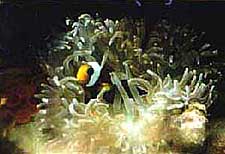One of the most interesting aspects of the coral reef community involves partnerships formed between different species of fishers or between a fish and an invertebrate organism. If the association is beneficial in some way to both partners the relationship is commonly referred to as symbiosis. On the other hand, commensalism is a term often used for a relationship in which only one of the two animals obtains some sort of advantage. Common examples of commensalism are the relationships that exist between remoras or sharksuckers and larger marine fishes, especially sharks and rays. The dorsal fin of the remora is specially modified to form a sucking apparatus that is used for attachment to the host. The remora benefits by saving energy due to its limited swimming and obtains food scraps when its host is feeding. Another classic example is the association existing between the man-of-war fishes (Nomeidae) that congregate among the deadly tentacles of jellyfish. This behavior enables them to escape larger predators. Certain jacks (Carangidae) exhibit this behavior only during their youth. The relationship is terminated when they attain a sufficient size and degree of mobility to render them less vulnerable.
Perhaps the best documented case of symbiosis is the one involving the anemonefishes of the genus Amphiprion (Pomacentridae) that dwell among the tentacles of tropical sea anemones. The latter animals are capable of stinging most fishes, but the anemonefishes possess a special mucous coating that somehow prevents the discharge of the anemone's stinging cells. Both partners apparently benefit from the relationship. The fish is protected from predators by the stinging cells and the anemone, in turn, is guarded against anemone-eating fishes by its highly territorial fish occupants.
The anemonefishes also keep the surface of their host free of silt and other debris, and it has been suggested that they also serve as decoys that lure fishes into the deadly tentacles of the anemone, thus providing anemone's food. However studies in nature indicate that this does not occur. Most of the large tropical anemones feed mainly on plankton that is swept into the tentacles by the currents. Another fallacy involves the deliberate feeding of the anemone by the fish occupants. This behavior is easily induced in aquarium surroundings but rarely is seen in nature.

A symbiotic relationship similar to that of anemones and damselfishes is seen between tiny clingfishes of the genus Lepadichthys (Gobiesocidae) and tropical comasteroid crinoids, commonly known as sea lilies. The fish is remarkably well camoflaged and uses the tentacles of the crinoid for shelter. Also it probably utilizes the planktonic food that adheres to the sticky tentacles of its host. Crinoids provide concealment for several other small reef animals included shrimps, crabs, and brittle stars.
Another well known case of symbiosis involves srasses of the genus Labroides and other members of the reef fish community. The wrasses or cleanerfishes feed upon the external parasites and diseased or damaged tissues of other fishes, thus providing a beneficial health service. Studies in which cleanerfishes have been experimentally removed from a section of reef resulted in significant increases in parasitism and disease. The cleaners are very meticulous with their inspections, often entering the mouth or gills of voracious predators such as groupers, snappers, and moray eels with total impunity. The shrimp genus Stenopus and several other fishes, most notable the young of wrasses, butterflyfishes, and angelfishes, also sometimes serve as ectoparasite cleaner.

